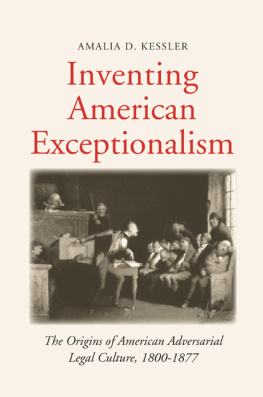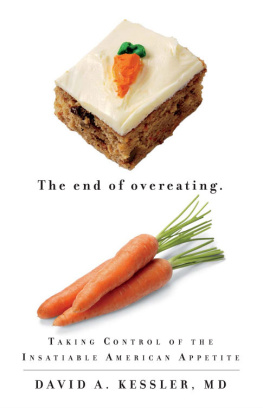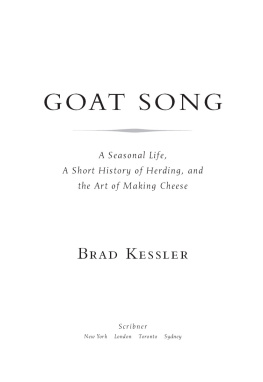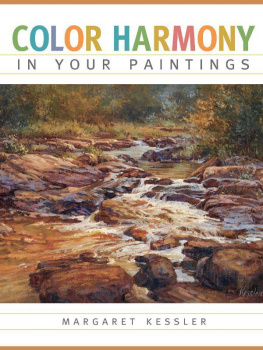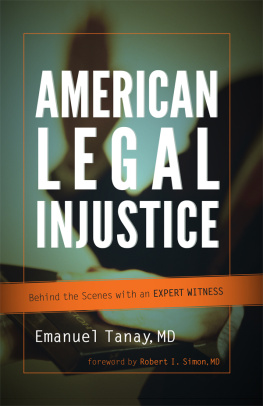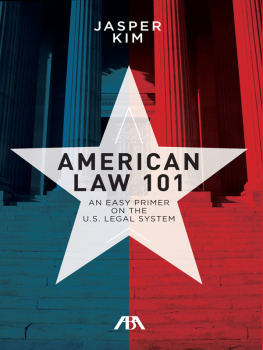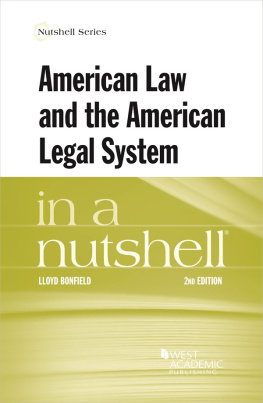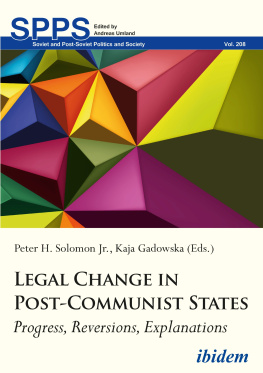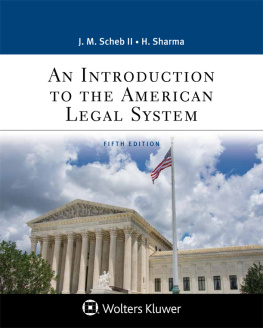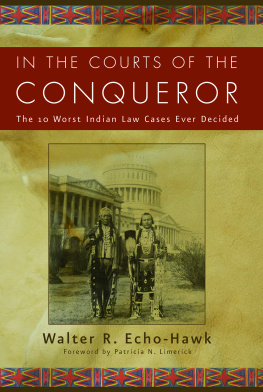I NVENTING A MERICAN
E XCEPTIONALISM
Yale Law Library Series in Legal History and Reference

Published with support from the Lillian Goldman Law
Library, Yale Law School.
Copyright 2017 by Amalia D. Kessler.
All rights reserved.
This book may not be reproduced, in whole or in part, including illustrations, in any form (beyond that copying permitted by Sections 107 and 108 of the U.S. Copyright Law and except by reviewers for the public press), without written permission from the publishers.
Yale University Press books may be purchased in quantity for educational, business, or promotional use. For information, please e-mail (U.K. office).
Set in Scala type by IDS Infotech Ltd., Chandigarh, India.
Printed in the United States of America.
Library of Congress Control Number: 2016944171
ISBN: 978-0-300-19807-2 (hardcover : alk. paper)
ISBN: 978-0-300-22225-8 (paperback : alk. paper)
A catalogue record for this book is available from the British Library.
This paper meets the requirements of ANSI / NISO
Z39.48-1992 (Permanence of Paper).
10 9 8 7 6 5 4 3 2 1
For Adam, Stella, and Ari
We should scarcely like our enemies to call us a litigious people, and yet there is no nation where members of the legal profession more abound, or where Courts of Law are so crowded with litigants.
Something of this may be attributed to the facilities which are afforded to the bringing of suits at law, and to the comparatively light expense attendant upon their prosecution; but much more may be ascribed to a peculiarity of temperament. We are a keen, shrewd, energetic, business people, tenacious of our rights, even to the tenth part of a hair, and resolutely bent upon defending them.
Courts of Conciliation, Alexandria Gazette, January 21, 1856, p. 2.
C ONTENTS
A CKNOWLEDGMENTS
In researching and writing this book, I benefited enormously from the wisdom and generosity of a great many people and institutions. A remarkable number of colleagues, both at Stanford and elsewhere, took the time to read the entire draft manuscript and provide me with detailed comments. Indeed, some read more than one draft! These include Jud Campbell, Kevin Clermont, George Fisher, Lawrence Friedman, Bob Gordon, John Langbein, Rene Lettow Lerner, Bernie Meyler, Judith Resnik, Norm Spaulding, Rachel St. John, Jim Whitman, and John Witt. I am also very grateful to the anonymous reviewers whose helpful feedback was secured by Bill Frucht, my wonderful editor at Yale University Press, and to Martin Schneider for excellent copyediting.
In addition to those who read the manuscript in its entirety, an even larger number offered insights and advice concerning particular portions of the text (and/or particular images) in the context of formal presentations or more informal exchanges. These include Bruce Ackerman, Laura Appleman, Keith Baker, Daphne Barak-Erez, Denis Baranger, Felice Batlan, Leora Bilsky, Binyamin Blum, Susanna Blumenthal, Margaret Boittin, Tomiko Brown-Nagin, Steve Bundy, Sarah Burns, Paul Butler, Amy Cohen, Charlie Donahue, Sharon Driscoll, Laurie Edelman, Malcolm Feeley, Katherine Florey, David Fontana, Willy Forbath, Tom Gallanis, Nuno Garoupa, David Gerber, Bill Gerdts, Philip Girard, Paul Goldstein, Risa Goluboff, Jim Gordley, Ariela Gross, Dan Hamilton, Ron Harris, Jill Hasday, Deborah Hensler, Steve Heyman, James Berry Hill, Dan Ho, Adam Hofri-Winogradow, Morty Horwitz, Bob Kagan, Linda Kerber, Roy Kreitner, Alexi Lahav, Pnina Lahav, Adriaan Lanni, Claire Lemercier, David Lieberman, Assaf Likhovski, Peter Lindseth, Screven Lorillard, Ken Mack, Leo Mazow, Chuck McCurdy, Tom McSweeney, Ralf Michaels, Kerry Morgan, Cal Morrill, Alex Nemerov, Bill Novak, Josh Ober, Jim Oldham, Nick Parrillo, Moria Paz, Dylan Penningroth, Rogelio Prez-Perdomo, Wilfrid Prest, Claire Priest, Sally Richardson, Noya Rimalt, Susan Rose-Ackerman, Issi Rosen-Zvi, Richard Ross, Yoram Shachar, Jed Shugerman, Reva Siegel, Nomi Stolzenberg, Eleanor Swift, Symeon Symeonides, Chris Tomlins, Avishalom Tor, Mark Tushnet, Amanda Tyler, Barbara Welke, Steven Wilf, and Caroline Winterer. So many have generously shared their knowledge and ideas with me that I fear I may have inadvertently neglected to thank some. My deepest apologies to anyone I mistakenly omitted.
I am also very grateful to the organizers and participants of the following workshops and speaker series to which I was invited to present portions of the book: the Australian and New Zealand Law and History Society Conference Keynote; the Berkeley Center for the Study of Law and Society Speaker Series; the Berkeley Civil Justice Workshop; the Berkeley Comparative Law and Economics Forum; the Chicago-Kent Law Faculty Workshop; the Duke Global Law Workshop; the George Washington Law School Works in Progress Series; the Haifa Law Faculty Workshop; the Harvard Law and History Workshop; the Hebrew University Legal History Workshop; the Illinois Legal History Program; the Institut Michel Villey/Paris II Speaker Series; the Iowa Legal History Workshop; the Ohio State/Moritz Law Faculty Workshop; the Osgoode Hall Law School Genest Global Faculty Lecture; the Stanford Humanities Center Works in Progress Series; the Stanford Law Faculty Workshop; the Tel Aviv Law and History Workshop; the Tel Aviv Law Faculty Workshop; the Tulane Law Faculty Workshop; the University of California Davis Law Faculty Workshop; the University of Connecticut Legal History and Culture Speaker Series; the University of Minnesota Legal History Workshop; the University of Minnesota Public Law Workshop; the University of Southern California Law, History, and Culture Workshop; the University of Virginia Legal History Workshop; the Willamette Law Faculty Workshop; the William and Mary Law Elmer J. Schaefer Workshop; the Yale Law Faculty Workshop; and the Yale Legal History Forum.
The amazing staff of the Stanford Law School Library contributed enormously to this project through their many efforts to assist me in locating and obtaining vital source materials. While I am hugely grateful to the library staff as a whole, I owe special thanks to Sonia Moss and Rich Porter. I also benefited greatly from the good counsel of James Folts, head of Reference Services at the New York State Archives. Many thanks as well to the research assistants who offered key help in tracking down sources: Mark Axelrod, Gilat Bachar, Hannah Chartoff, Jon Connolly, Gea Kang, Amanda Klein, George LeBourdais, Jennifer Luo, Andy Schupanitz, Tommy Tobin, and Zain Yoonas. So, too, I am indebted to the incredible Eun Sze, who, along with Ginny Clegg, provided much-needed assistance in preparing the manuscript for submission, and to Jaya Chatterjee of Yale University Press, who helped a great deal in this process as well.
Research for the book was supported, in part, through generous fellowships provided by a number of organizations, to all of which I am tremendously grateful. These include a Charles A. Ryskamp Research Fellowship from the American Council of Learned Societies; a research fellowship within the Workshop on Common Law Legal Transplants hosted by the Institute for Advanced Studies of the Hebrew University of Jerusalem; and a Violet Andrews Whittier Fellowship at the Stanford Humanities Center. I also owe a great debt to two wonderful Stanford Law School deans, Larry Kramer and Liz Magill, who supported my research in numerous ways, including by making it possible for me to pursue these fellowship opportunities.
Portions of the material published here have appeared previously in different form: Our Inquisitorial Tradition: Equity Procedure, Due Process, and the Search for an Alternative to the Adversarial,
Next page
